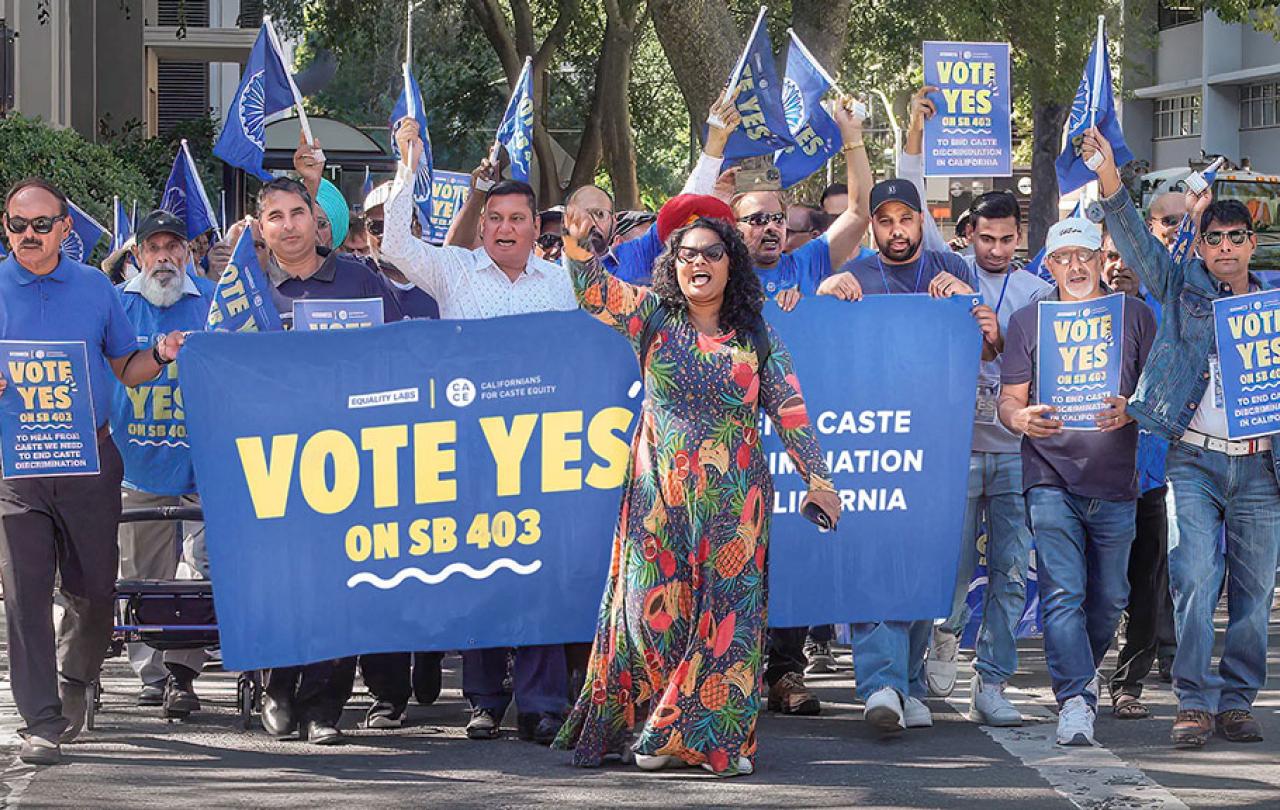
Cisco is a highly successful California based tech company. It has an annual revenue of $57 billion and boasts of many awards and prizes. Great Place to Work placed Cisco at number one on its 2023 list. But what has this to do with caste discrimination? Well, 33 per cent of Cisco’s 84,000 employees are of Indian origin and the company is struggling under a lawsuit currently upheld by the California Department of Fair Employment and Housing. The widely reported lawsuit is for caste discrimination against a Dalit (Untouchable) employee. The engineer has claimed to be paid less than his peers due to his low caste status.
Is this common? Well, the high caste Brahmin CEO of Google, Sunder Pichai (of Indian origin) has also faced allegations, raised by California based civil rights organisation, Equality Labs, of “caste bigotry” that is “running rampant” within his company.
“You can take an Indian out of India but you can never take India out of an Indian.” This was the sorrow filled saying I heard amongst well meaning fellow Indians whilst growing up in the United Kingdom. It usually cropped up when my Indian relatives and friends were confused by the appalling attitudes of other fellow Indians and trust me, it was quite common.
In October 2023, the Governor of California, Gavin Newsom vetoed a Bill to outlaw caste-based discrimination across his state. His decision was met with anger and rage from low caste Indian Dalits and from those who are fighting alongside them to ban discrimination amidst this rigid but ancient Hindu social structure.
It may surprise us in the west that the city of Seattle in Washington State was the first city in the USA to outlaw caste discrimination followed by Fresno in California.
But is this just a moral battle against an enemy that doesn’t really exist and a lame excuse to protest away with ‘Dalit Lives Matter?’ Or is there a tiny surreptitious fire carefully kindling away underneath the blinding smoke that mustn’t go unnoticed? After all, we are in the west…right? Of course we believe in equality…right?
The Swaminarayan Movement, America’s largest and most influential Hindu tradition saw the FBI raid it's temple compound in Robbinsville, New Jersey in 2021 for illegally importing Indians from India and illegally paying them below the national wage as well as confining them to the temple compound. The FBI raid rescued 200 workers who were largely from Dalit or Tribal castes.
When I was training in India to be a Hindu monk I remember recognising the harsh reality of the caste system in one single moment. One day, after I had finished a conversation with a friend in the temple compound I turned to head back to my room when I saw a young boy waving to me far away from the temple gates. I waved back and gestured to him to come in and talk but he stayed rooted to the spot. A little confused, I walked over and asked, “why don’t you come inside the compound?”
“I can’t.” He said,
“Why?”
“I’m a Dalit…I can’t even touch you!”
Thinking back over that mind numbing moment I can’t help imagine how hard it must have been for the woman in the Bible with the issue of blood who touched the hem of Jesus’s garment within the rigid culture of the time. The difference I guess is that Jesus turned to the broken hearted woman and healed her and then called her ‘daughter’ and defined her real identity as a result.
If the Dalit boy on the other hand came into the temple compound that day the security guards would have typically hit him with a long stick to drive him out of the temple gates. If he had touched me in the meantime I would have had to immediately go for a bath with all my clothes on and ensure that I didn’t touch any other human being or even a book or a pot on the way!
PM Modi’s comment has a pernicious and curious undertone. If Dharma is first then one is obliged to follow the caste system diligently.
Bhimrao. R Ambedkar was a brilliant economist and lawyer who studied at the London School of Economics. When his genius mind was called upon to draft the new constitution for independent India he was all too aware of how Hinduism was not so compatible with democracy. The idea of equality and dignity was evidently embedded into western institutions to his mind and Ambedkar knew very well that these ideas were founded on Judeo Christian principles, primarily, that all are created in the image of God. In other words, equal. Being a Dalit himself, Bhimrao knew the pitfalls of Hinduism’s caste system and the anarchical society it would create if the institutions left behind by the British were replaced with caste based ideas. As a result he crafted a constitution based upon Christian principles ensuring that all castes were allowed the opportunities and privileges from the state and its institutions by law. Sadly, although the state provided those privileges and protections by law in 1952 when the constitution came into effect, the society in India at large until this day does not. India exports it to the west as well.
When the current Indian Prime Minister Narendra Modi gave his speech on National Human Rights Day in India a few years ago he emphasised to the nation that Dharma needs to be held first before Human Rights… if Dharma is pursued, he insisted, Human Rights would follow. Dharma simply put, is to pursue one’s duty and righteousness as according to Hindu tradition.
At a quick glance here one is reminded of what Alexander Solzhenitsyn said during his Harvard Commencement Speech in 1978. He told his audience that it was time that the west upheld human obligation more than human rights. He had a valid point to state in a significantly individualistic culture which still prevails in the west but PM Modi’s comment has a pernicious and curious undertone. If Dharma is first then one is obliged to follow the caste system diligently.
It has taken an incredibly long time to carve away at the negatives of the caste system in India but it is nowhere near the end.
Krishna who is the most widely revered incarnation of God in the Hindu world told his disciple Arjuna to fight and kill his cousins and teachers on the battlefield of Kurukshetra as it was his Dharma to do so. As a Kshatriya warrior caste Arjuna was not meant to meditate in the forest but fight and kill, as is laid out quite clearly in the beginning chapter of the Bhagvad Gita scripture.
Although the Gita scripture is quite a complex context to unravel here, in today’s India and in large parts of the west placing Human Rights behind Dharma can be quite dangerous. It somewhat validates the violence towards those of other faiths and endorses a dislike to those of a lower caste.
The need for individual freedom from caste based social structures in India was introduced to the British Parliament by William Wilberforce and Charles Grant in 1793. Interestingly, it was the same year that the cobbler-turned missionary William Carey snuck into India against the rules of the British East India Company. The company knew that if missionaries entered the country they would battle against the unfair social order and upset the high caste Brahmins. And that would hinder their lucrative trade.
Wilberforce and Grant along with other devout Christians fought in Parliament for 20 years until in 1813 a law was passed to allow missionaries passage into India. These men and women of God began to transform the subcontinent and provide education and health care for all castes. Teaching and training the Indian mind that God created male and female first (in his image) and they then created a social order as per God’s guidance whilst cautiously deconstructing the idea of God creating a social order first and male and female after.
It has taken an incredibly long time to carve away at the negatives of the caste system in India but it is nowhere near the end.
Sadly, the caste hierarchy has infiltrated parts of the Christian faith in India too. Dalit Christians who are made in the image of God cannot enter certain churches.
What fascinates me however, is when a Dalit leaves India, in most cases, a lot of India leaves them! They are quite successful. In a society like India one is made to believe (in large part by the communities) that past life karma has destined the individual to be a Dalit and so one must continue to clean the gutters and carry away dead dogs. But when a Dalit enters into a land like the USA or the UK where notions of equality and freedom are based upon Christian values the thinking of that individual changes drastically. A Dalit engineer filing a case against his seniors is inconceivable in large parts of the Indian community in India.
But the issue of caste is not the domain of Hinduism alone. Buddhism in Sri Lanka and Myanmar is very much entrenched in a caste based order which is quite an irony as abuse of this social order was one of the main reasons Gautam Buddha established the faith.
Sadly, the caste hierarchy has infiltrated parts of the Christian faith in India too. Dalit Christians who are made in the image of God cannot enter certain churches and where they can in some parts they are not allowed to sit in the pews but on the floor, at the back.
Author E.M Forster lovingly did say that India is both a mystery and a muddle.
The late Christian and author John Stott wrote in his book The Cross that Jesus was facing the most excruciating pain in the garden of Gethsemane not because of the cross and its horrific nails but because Christ was about to be touched by sin. God readily touches us even though we are untouchable.
The relentless work by William Carey, Wilberforce, Grant and other Indian reformers began to change the Indian mindset primarily by introducing the notion of love and freedom at every level of Indian society. Do we have the will to continue respectfully that fight?





